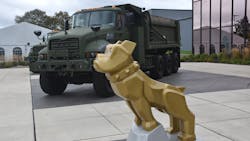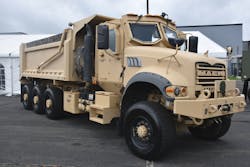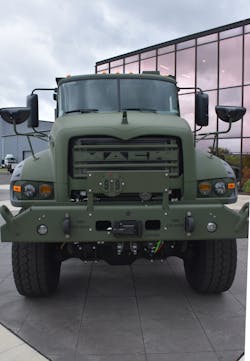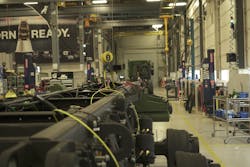Mack Defense delivers Granite-based dump truck to U.S. Army
ALLENTOWN, Pennsylvania—Note to truck manufacturers looking to win a nine-figure U.S. Army contract: Start with a commercially available vehicle that’s already 80% of the way to the top-tier military spec, then invest in your own design engineering and testing to make a good first impression. Then, with the pre-production contract in hand, collaborate, collaborate, collaborate with the government’s project management team at every stage—over every detail—of product development.
That’s the approach that led to Mack Defense’s Sept. 23 delivery of the first production M917A3 Heavy Dump Trucks (HDT) to the Army and Army Reserve. The trucks rolled off Mack Defense’s new, dedicated production line here at the Mack Experience Center (MEC).
The M917A3 HDT handover ceremony took place at the MEC, following remarks from Mack Defense leadership and Army officials. Attendees also were given a tour of Mack Defense’s new production facility.
“It’s an honor to write the next chapter in Mack’s rich history of producing vehicles for the U.S. armed forces on this dedicated line and deliver the first, new Heavy Tactical Wheeled Vehicle the U.S. Army has added to their portfolio in 12 years,” said David Hartzell, president of Mack Defense. “The HDT represents a perfect example of where commercial technology and value meets military readiness.”
Based on the commercially available vocational Mack Granite model, the M917A3s are part of the contract for HDTs that was previously announced between the Army and Mack Defense. The Army uses dump trucks in its engineer units. They are key in construction and maintenance missions for important infrastructure assets such as roadways, airfields, landing strips, supply facilities, and motor pools.
While the Mack Granite served as the base for the HDT, the commercially available truck required some specialty components to meet unique military requirements such as off-road performance and survivability.
Hartzell credited several supplier partners, including:
- CRYSTEEL, for the dump body coupled with their unique Material Control System tailgate
- Meritor Defense, for front and rear axles, brake systems, transfer case, and driveshafts
- Hendrickson, for the rear suspension system
- TenCate Advanced Armor, for the engineering design of the force protection system
- JWF Defense, for fabrication of the armored cab, plus more than 30 parts, subassemblies, and JWF's mil-spec Chemical Agent Resistant Coating (CARC) painting expertise used on every HDT
- Jankel, for the blast seats and floor mats
- XPER, for the transparent armor
- Allison Defense, for the automatic transmission
- XMCO, for its Integrated Logistics Support expertise
Team effort
Even before the proposal went out to truck manufacturers, the Army had its own internal review where it debated and defined the most workable and effective concept—a balance of “a whole slew” of priorities, as Andrew DiMarco, acting program executive officer for Combat Support & Combat Service Support, explained.
And then the competition parameters had to be set, and the testing and evaluation planned to select a winner. Ultimately, the bottom line is whether the truck will get the job done when soldiers “go into harm’s way” and that vehicle’s performance also must be affordable and sustainable.
“The Heavy Dump Truck is a great example of where we bring an intersection of commerciality—with somewhere in the neighborhood of 75 to 80% commonality with commercial truck—with the military-unique requirements,” DiMarco said.
And that means the truck had to perform as advertised. Then the evaluators at the Army's Aberdeen Test Center in Aberdeen, Maryland, blew it up—an extreme form of crash test—before putting it back together again. Thus the “affordable and sustainable” requirements.
“We had to go on a scouting mission to find the bulldog,” DiMarco recalled, referring to the iconic Mack hood ornament, found still attached after the test blast. “But it was successful, and the truck is delivering the performance we were looking for at the outset.”
The Army's current dump truck fleet includes some variants that are nearly 50 years old, noted Wolfgang Petermann, the Army's project manager for transportation systems.
"Now is the perfect time to provide the Engineer Regiment with modified commercial off-the-shelf capabilities leveraging the strength of the commercial auto and heavy-duty trucking industry,” Petermann said. "Today's ceremony is a huge milestone in delivering that enhanced capability, which is better equipped to maintain the operational pace of the modern battlefield. I'm proud of the hard-working Heavy Dump Truck team that has brought us to this point."
Brig. Gen. Mark Merlino, deputy chief of engineers, National Guard Affairs, echoed the message of teamwork and collaboration that was the theme of the day.
“Winning matters,” Merlino said. “I want to congratulate Mack, because you know what winning’s all about. You won this contract, and it wasn't easy. Partnerships made it happen.”
In May 2018, the Army awarded Mack Defense the contract that could be worth up to $296.4 million over seven years to produce up to 683 non-armored and armored M917A3 HDTs. The Army signed the agreement on Nov. 30, 2020, to buy 99 Mack Granite-based HDT’s after completing two years of successful production vehicle testing of 12 vehicles at the Aberdeen Test Center, in accordance with the contract program timeline. Then, on March 29 this year, an additional order of 56 HDTs were placed as part of the 2021 federal budget.
Granite foundation
The 94,500 lb. GVWR M917A3 HDTs based on the Mack Granite model feature an all-wheel drive 8x8 configuration. Mack Defense engineers increased the suspension’s ride height to create a heavy dump truck capable of meeting the demanding payload and mobility requirements set by the Army's HDT program.
An armored cab also was engineered, utilizing all the comfort features and amenities of a commercial truck, while adding force protection to help keep occupants safe in hostile environments. The M917A3s are powered by 13-liter Mack MP8 engines, delivering 440hp and 1,660 lb.-ft. of torque.
“It was easy to do on our Granite product because it’s already one of the best vehicles for this type of application,” Hartzell said. “They're looking for the technology that the commercial vehicle industry brings. For us to stay competitive in our market space, we have to develop and create a lot of those technologies—whether it's advanced safety systems, e-mobility, all those things—we're developing that as part of Mack and the global Volvo Group."
“It’s important for the Army because we're going to sell those things in large volumes around the world, and they want that technology,” he added. “And our volume base is much higher than your typical defense contractor’s overall volumes, so that gives us more purchasing capability and we can keep the cost at a better price point.”
But, Hartzell emphasized, Mack Defense also had to prove the truck works.
“They put the vehicle through its paces—I mean 100% through its paces,” he said.
Interestingly, Hartzell noted that the Army did not ask for a telematics gateway, largely due to battlefield security concerns. But the benefits of remote vehicle monitoring and diagnostics became apparent in the testing phase, so the National Guard—which also operates domestically—is exploring the advantages of the Mack GuardDog Connect solution with mil-spec’d cybersecurity.
Indeed, the modifications go both ways, with Mack Defense passing along improvements that will be incorporated into the Mack Granite, Hartzell added.
“There was a bunch of little things that that came up, even if it was just improvements in routing and clamping,” he said. “I don’t know where they get their mud at Aberdeen, but it clings to the trucks really incredibly. So if air hoses or electrical lines are not properly clamped, you're going to get a failure.
“That’s all communicated back to Mack, for the base Mack products.”
About the Author
Kevin Jones
Editor
Kevin has served as editor-in-chief of Trailer/Body Builders magazine since 2017—just the third editor in the magazine’s 60 years. He is also editorial director for Endeavor Business Media’s Commercial Vehicle group, which includes FleetOwner, Bulk Transporter, Refrigerated Transporter, American Trucker, and Fleet Maintenance magazines and websites.
Working from Beaufort, S.C., Kevin has covered trucking and manufacturing for nearly 20 years. His writing and commentary about the trucking industry and, previously, business and government, has been recognized with numerous state, regional, and national journalism awards.


!['[The modification] was easy to do on our Granite product because it’s already one of the best vehicles for this type of application,” says David Hartzell, president of Mack Defense. '[The modification] was easy to do on our Granite product because it’s already one of the best vehicles for this type of application,” says David Hartzell, president of Mack Defense.](https://img.fleetowner.com/files/base/ebm/fleetowner/image/2021/09/Mack_HDT_Hartzell.6155bb53d9189.png?auto=format,compress&fit=max&q=45&w=250&width=250)



